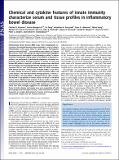| dc.contributor.author | Knutson, Charles G. F. | |
| dc.contributor.author | Mangerich, Aswin | |
| dc.contributor.author | Zeng, Yu | |
| dc.contributor.author | Raczynski, Arkadiusz R. | |
| dc.contributor.author | Liberman, Rosa G. | |
| dc.contributor.author | Kang, Pilsoo | |
| dc.contributor.author | Ye, Wenjie | |
| dc.contributor.author | Prestwich, Erin | |
| dc.contributor.author | Lu, Kun | |
| dc.contributor.author | Wishnok, John S. | |
| dc.contributor.author | Korzenik, Joshua R. | |
| dc.contributor.author | Wogan, Gerald N. | |
| dc.contributor.author | Fox, James G. | |
| dc.contributor.author | Dedon, Peter C. | |
| dc.contributor.author | Tannenbaum, Steven Robert | |
| dc.date.accessioned | 2015-05-08T15:07:34Z | |
| dc.date.available | 2015-05-08T15:07:34Z | |
| dc.date.issued | 2013-06 | |
| dc.date.submitted | 2012-11 | |
| dc.identifier.issn | 0027-8424 | |
| dc.identifier.issn | 1091-6490 | |
| dc.identifier.uri | http://hdl.handle.net/1721.1/96939 | |
| dc.description.abstract | Inflammatory bowel disease (IBD) arises from inappropriate activation of the mucosal immune system resulting in a state of chronic inflammation with causal links to colon cancer. Helicobacter hepaticus-infected Rag2[superscript −/−] mice emulate many aspects of human IBD, and our recent work using this experimental model highlights the importance of neutrophils in the pathology of colitis. To define molecular mechanisms linking colitis to the identity of disease biomarkers, we performed a translational comparison of protein expression and protein damage products in tissues of mice and human IBD patients. Analysis in inflamed mouse colons identified the neutrophil- and macrophage-derived damage products 3-chlorotyrosine (Cl-Tyr) and 3-nitrotyrosine, both of which increased with disease duration. Analysis also revealed higher Cl-Tyr levels in colon relative to serum in patients with ulcerative colitis and Crohn disease. The DNA chlorination damage product, 5-chloro-2′-deoxycytidine, was quantified in diseased human colon samples and found to be present at levels similar to those in inflamed mouse colons. Multivariate analysis of these markers, together with serum proteins and cytokines, revealed a general signature of activated innate immunity in human IBD. Signatures in ulcerative colitis sera were strongly suggestive of neutrophil activity, and those in Crohn disease and mouse sera were suggestive of both macrophage and neutrophil activity. These data point to innate immunity as a major determinant of serum and tissue profiles and provide insight into IBD disease processes. | en_US |
| dc.description.sponsorship | National Institutes of Health (U.S.) (Grant CA26731) | en_US |
| dc.description.sponsorship | Massachusetts Institute of Technology. Center for Environmental Health Sciences (Grant ES002109)) | en_US |
| dc.description.sponsorship | Massachusetts Institute of Technology (Merck Fellowship) | en_US |
| dc.description.sponsorship | German Academic Exchange Service (Fellowship) | en_US |
| dc.language.iso | en_US | |
| dc.publisher | National Academy of Sciences (U.S.) | en_US |
| dc.relation.isversionof | http://dx.doi.org/10.1073/pnas.1222669110 | en_US |
| dc.rights | Article is made available in accordance with the publisher's policy and may be subject to US copyright law. Please refer to the publisher's site for terms of use. | en_US |
| dc.source | Tannenbaum | en_US |
| dc.title | Chemical and cytokine features of innate immunity characterize serum and tissue profiles in inflammatory bowel disease | en_US |
| dc.type | Article | en_US |
| dc.identifier.citation | Knutson, C. G., A. Mangerich, Y. Zeng, A. R. Raczynski, R. G. Liberman, P. Kang, W. Ye, et al. “Chemical and Cytokine Features of Innate Immunity Characterize Serum and Tissue Profiles in Inflammatory Bowel Disease.” Proceedings of the National Academy of Sciences 110, no. 26 (June 10, 2013): E2332–E2341. | en_US |
| dc.contributor.department | Massachusetts Institute of Technology. Department of Biological Engineering | en_US |
| dc.contributor.department | Massachusetts Institute of Technology. Division of Comparative Medicine | en_US |
| dc.contributor.department | Massachusetts Institute of Technology. School of Science | en_US |
| dc.contributor.approver | Tannenbaum, Steven Robert | en_US |
| dc.contributor.mitauthor | Knutson, Charles G. F. | en_US |
| dc.contributor.mitauthor | Mangerich, Aswin | en_US |
| dc.contributor.mitauthor | Zeng, Yu | en_US |
| dc.contributor.mitauthor | Raczynski, Arkadiusz R. | en_US |
| dc.contributor.mitauthor | Liberman, Rosa G. | en_US |
| dc.contributor.mitauthor | Kang, Pilsoo | en_US |
| dc.contributor.mitauthor | Ye, Wenjie | en_US |
| dc.contributor.mitauthor | Prestwich, Erin | en_US |
| dc.contributor.mitauthor | Lu, Kun | en_US |
| dc.contributor.mitauthor | Wishnok, John S. | en_US |
| dc.contributor.mitauthor | Wogan, Gerald N. | en_US |
| dc.contributor.mitauthor | Fox, James G. | en_US |
| dc.contributor.mitauthor | Dedon, Peter C. | en_US |
| dc.contributor.mitauthor | Tannenbaum, Steven Robert | en_US |
| dc.relation.journal | Proceedings of the National Academy of Sciences | en_US |
| dc.eprint.version | Final published version | en_US |
| dc.type.uri | http://purl.org/eprint/type/JournalArticle | en_US |
| eprint.status | http://purl.org/eprint/status/PeerReviewed | en_US |
| dspace.orderedauthors | Knutson, C. G.; Mangerich, A.; Zeng, Y.; Raczynski, A. R.; Liberman, R. G.; Kang, P.; Ye, W.; Prestwich, E. G.; Lu, K.; Wishnok, J. S.; Korzenik, J. R.; Wogan, G. N.; Fox, J. G.; Dedon, P. C.; Tannenbaum, S. R. | en_US |
| dc.identifier.orcid | https://orcid.org/0000-0002-5811-6853 | |
| dc.identifier.orcid | https://orcid.org/0000-0003-0011-3067 | |
| dc.identifier.orcid | https://orcid.org/0000-0003-0771-9889 | |
| dc.identifier.orcid | https://orcid.org/0000-0002-2325-552X | |
| dc.identifier.orcid | https://orcid.org/0000-0001-9307-6116 | |
| mit.license | PUBLISHER_POLICY | en_US |
| mit.metadata.status | Complete | |
